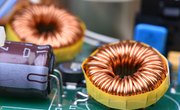
Invented in the early 1980s, neodymium magnets are, as of 2009, the strongest kind of permanent magnet available. Their strength, small size and low cost have made numerous advances in personal audio, electric motors and other areas possible.
Neodymium magnets are made of an alloy called NIB--neodymium, iron and boron. They belong to the rare-earth class of magnets, that is, metal magnets made with rare-earth elements. The arrangement of electrons in rare-earth elements lets them develop strong magnetic fields. Rare-earth elements are expensive, but the magnetic fields are so strong that you can make the magnets very small. The smaller magnets end up being less expensive.
As with other strongly magnetic materials, NIBs are brittle, so the magnets get a protective coating of a stronger metal, like nickel, or a more resilient material, such as plastic.
Currently, NIB magnets come in a range of strength grades, from N24, the lowest, to N55. A magnet rated N45 will have a 1.25 Tesla field. This is approaching the magnetic power of medical MRIs, which require a special, metal-free room. MRIs have magnets that run about 3 Teslas.
All ferromagnetic materials lose their magnetism with heating; the temperature where they lose their magnetism is called the Curie Point. Neodymium magnets lose their strength between 80 degrees C and 230 degrees C, depending on the grade. While this is higher than room temperature (25 degrees C), it’s lower than many other magnetic materials.
NIB magnets made earbud earphones possible. In order to make a tiny earphone handle enough power to make it sound good, the magnets in the audio transducers need a strong magnetic field. While earphones existed before neodymium magnets, they weren’t suitable for high-fidelity listening. The small size and good fidelity of earbuds helped make the MP3 player phenomenon a success.
Hobbyists have adopted NIB magnets for a variety of uses. Stuck to a steel shelf, they can hold knives and tools. They’re used for couplers on model railroad cars. Electric motors improved with NIB magnets are replacing internal combustion engines for model airplanes, boats and cars.
The stronger grades of NIB magnets have some hazards worth knowing. Two of them can attract each other with enough force to shatter themselves, or to break your fingers if your hand’s in the way. If swallowed, two magnets can pinch the digestive tract, causing pain and serious injury. The strong magnetic fields can interfere with pacemakers. They’re also strong enough to erase floppy disks or the magnetic stripe on a credit card. Larger NIB magnets can’t be air-shipped as they can interfere with the plane’s navigational compass.
About the Author
Chicago native John Papiewski has a physics degree and has been writing since 1991. He has contributed to "Foresight Update," a nanotechnology newsletter from the Foresight Institute. He also contributed to the book, "Nanotechnology: Molecular Speculations on Global Abundance." Please, no workplace calls/emails!
Photo Credits
Image by Flickr.com, courtesy of Byrion Smith
